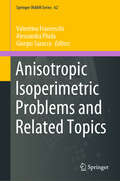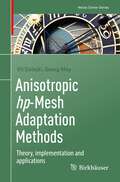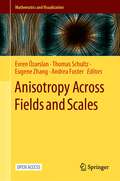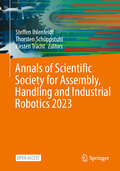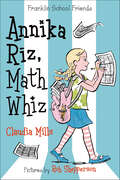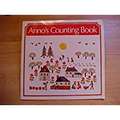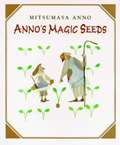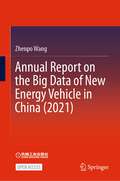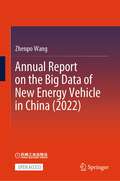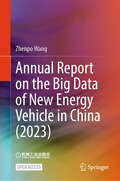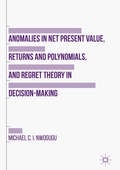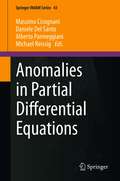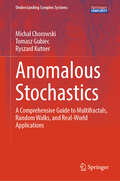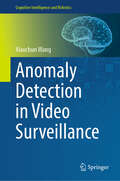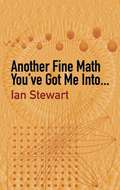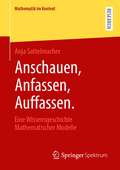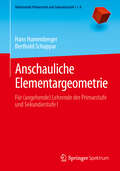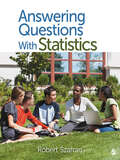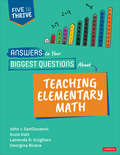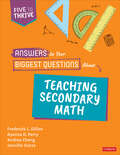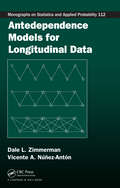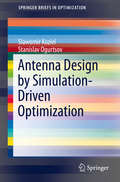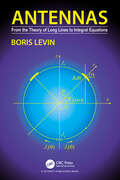- Table View
- List View
Anisotropic Isoperimetric Problems and Related Topics (Springer INdAM Series #62)
by Valentina Franceschi Alessandra Pluda Giorgio SaraccoThis book contains contributions from speakers at the "Anisotropic Isoperimetric Problems & Related Topics" conference in Rome, held from Sep 5 to 9, 2022. The classic isoperimetric problem has fascinated mathematicians of all eras, starting from the ancient Greeks, due to its simple statement: what are the sets of a given volume with minimal perimeter? The problem is mathematically well understood, and it plays a crucial role in explaining physical phenomena such as soap bubble shapes. Variations of the problem, including weighted counterparts with density dependencies, representing inhomogeneity and anisotropy of the medium, broaden its applicability, even in non-Euclidean environments, and they allow for descriptions, e.g., of crystal shapes. At large, the perimeter's physical interpretation is that of an attractive force; hence, it also appears in describing systems of particles where a balance between attractive and repulsive forces appears. A prominent example is that of Gamow's liquid drop model for atomic nuclei, where protons are subject to the strong nuclear attractive force (represented by the perimeter) and the electromagnetic repulsive force (represented by a nonlocal term). Such a model has been shown to be sound, as it explains the basic characteristics of the nuclei, and it successfully predicts nuclear fission for nuclei with a large atomic number. Similar energy functionals model various physical and biological systems, showcasing the competition between short-range interfacial and long-range nonlocal terms, leading to pattern formation. The authors mention, e.g., the Ohta–Kawasaki model for microphase separation of diblock copolymers and the Yukawa potential for colloidal systems. Despite diverse systems, the emergence of microphases follows similar patterns, although rigorously proving this phenomenon remains a challenge. The book collects several contributions within these topics, shedding light on the current state of the art.
Anisotropic hp-Mesh Adaptation Methods: Theory, implementation and applications (Nečas Center Series)
by Vít Dolejší Georg MayMesh adaptation methods can have a profound impact on the numerical solution of partial differential equations. If devised and implemented properly, adaptation significantly reduces the size of the algebraic systems resulting from the discretization, while ensuring that applicable error tolerances are met. In this monograph, drawing from many years of experience, the authors give a comprehensive presentation of metric-based anisotropic hp-mesh adaptation methods.A large part of this monograph is devoted to the derivation of computable interpolation error estimates on simplicial meshes, which take into account the geometry of mesh elements as well as the anisotropic features of the interpolated function. These estimates are then used for the optimization of corresponding finite element spaces in a variety of settings. Both steady and time dependent problems are treated, as well as goal-oriented adaptation. Practical aspects of implementation are also explored, including several algorithms. Many numerical experiments using the discontinuous Galerkin method are presented to illustrate the performance of the adaptive techniques.This monograph is intended for scientists and researchers, including doctoral and master-level students. Portions of the text can also be used as study material for advanced university lectures concerning a posteriori error analysis and mesh adaptation.
Anisotropy Across Fields and Scales (Mathematics and Visualization)
by Thomas Schultz Andrea Fuster Evren Özarslan Eugene ZhangThis open access book focuses on processing, modeling, and visualization of anisotropy information, which are often addressed by employing sophisticated mathematical constructs such as tensors and other higher-order descriptors. It also discusses adaptations of such constructs to problems encountered in seemingly dissimilar areas of medical imaging, physical sciences, and engineering. Featuring original research contributions as well as insightful reviews for scientists interested in handling anisotropy information, it covers topics such as pertinent geometric and algebraic properties of tensors and tensor fields, challenges faced in processing and visualizing different types of data, statistical techniques for data processing, and specific applications like mapping white-matter fiber tracts in the brain.The book helps readers grasp the current challenges in the field and provides information on the techniques devised to address them. Further, it facilitates the transfer of knowledge between different disciplines in order to advance the research frontiers in these areas.This multidisciplinary book presents, in part, the outcomes of the seventh in a series of Dagstuhl seminars devoted to visualization and processing of tensor fields and higher-order descriptors, which was held in Dagstuhl, Germany, on October 28–November 2, 2018.
Annals of Scientific Society for Assembly, Handling and Industrial Robotics 2023
by Thorsten Schüppstuhl Kirsten Tracht Steffen IhlenfeldtThis open access book presents a good overview of the current research landscape of assembly, handling and industrial robotics. The objective of MHI Colloquium is the successful networking at both academic and management levels. Thereby, the colloquium focuses an academic exchange at a high level in order to distribute the obtained research results, to determine synergy effects and trends, to connect the actors in person and in conclusion, to strengthen the research field as well as the MHI community. In addition, there is the possibility to become acquainted with the organizing institute. Primary audience is formed by members of the scientific society for assembly, handling and industrial robotics (WGMHI).
Annika Riz, Math Whiz (Franklin School Friends #2)
by Claudia MillsAnnika Riz loves math more than anything, so when she hears about a sudoku contest at the local public library, she is determined to win it—maybe then her friends Kelsey Green and Izzy Barr will see that math is just as cool as reading and running. When the school carnival, the biggest fundraiser of the year, comes around, Annika realizes her class booth is losing money by selling their lemonade too cheaply. Annika embraces her math skills, saves the day, and shows her friends that math can be useful and even a bit of fun, too, in Claudia Mills's Annika Riz, Math Whiz.
Anno's Counting Book
by Mitsumasa AnnoFirst there is an empty field. The it is January, the first month of the year. All alone in the snow stands 1 yellow house. In front, 1 child builds a snowman. Behind the house is 1 tree and 1 black cow. Now, five months later, it is June. There are 6 buildings in the field, 6 children playing, and 6 adults working. One adult tends 6 ducks. Another drives a trains with 6 cars. From 1 to 12, through the months of the year, the town grows. More houses and trees and animals and people can be seen until December arrives with all it's magic.
Anno's Magic Seeds
by Mitsumasa AnnoThe reader is asked to perform a series of arithmetic operations integrated into the story of a man who plants magic seeds and reaps an increasingly abundant harvest. A story that helps children understand the process of plant growth.
Annual Report on the Big Data of New Energy Vehicle in China (2021)
by Zhenpo WangThis open access book, based on static indicators and dynamic big data from local electric vehicles, is the first New-Energy Vehicles (NEVs) research report on the Big Data in China.Using the real-time big data collected by China's National Monitoring and Management Platform for NEVs, this book delves into the main annual technological progress of NEVs, the vehicle operating characteristics, it also anticipates the trend of NEVs industry.Various graphs&charts, detailed data this book offers will familiarize readers with the operation characteristics and practical application of China's NEVs industry and popularize the concept of automobile electrification. Besides, this book also makes an objective evaluation of the current situation and technological improvement of China's NEVs industry, presenting sensible suggestions for the development of the industry.This book is written for government staff, researchers, college staff, and technical staff of automobile and spare parts enterprises, which serves as an important reference for the decision-making of government departments and strategic decisions of automotive companies.
Annual Report on the Big Data of New Energy Vehicle in China (2022)
by Zhenpo WangThis is an Open Access book. This book based on static indicators and dynamic big data from local electric vehicles, is the first New-Energy Vehicles (NEVs) research report on the Big Data in China. Using the real-time big data collected by China's National Monitoring and Management Platform for NEVs, this book delves into the main annual technological progress of NEVs, the vehicle operating characteristics, it also anticipates the trend of NEVs industry.Various graphs & charts, detailed data this book offers will familiarize readers with the operation characteristics and practical application of China's NEVs industry and popularize the concept of automobile electrification. Besides, this book also makes an objective evaluation of the current situation and technological improvement of China's NEVs industry, presenting sensible suggestions for the development of the industry.This book is written for government staff, researchers, college staff, and technical staff of automobile and spare parts enterprises, which serves as an important reference for the decision-making of government departments and strategic decisions of automotive companies.
Annual Report on the Big Data of New Energy Vehicle in China (2023)
by Zhenpo WangThis open access book, based on static indicators and dynamic big data from local electric vehicles, is the first research annual report on the Big Data of New Energy Vehicles (NEVs) in China. Using the real-time big data collected by China's National Monitoring and Management Platform for NEVs, this book delves into the main annual technological progress of NEVs, the vehicle operating characteristics, and it also anticipates the trend of NEVs industry. Various graphs and charts and detailed data this book will familiarize readers with the operation characteristics and practical application of China's NEVs industry and popularize the concept of automobile electrification. Besides, this book also makes an objective evaluation of the current situation and technological improvement of China's NEVs industry, presenting sensible suggestions for the development of the industry. This book is written for government staff, researchers, college staff, and technical staff of automobile and spare parts enterprises, which serves as an important reference for the decision-making of government departments and strategic decisions of automotive companies.
Anomalies in Net Present Value, Returns and Polynomials, and Regret Theory in Decision-Making
by Michael C. I. NwoguguThis book explores why Modified Internal Rate of Return (MIRR) and Net Present Value (NPV) are not necessarily accurate or efficient tools for valuation and decision-making. The author specifically addresses the biases and framing effects inherent in the NPV/MIRR/IRR model and in related approaches such as Adjusted Present Value (APV), Net Future Value (NFV), and by extension, Polynomials. In doing so, the book presents new ways of solving higher order polynomials using invariants and homomorphisms and explains why the "Fundamental Theorem of Algebra", the Binomial Theorem and the "Descartes Sign Rule" are unreliable. Chapters also discuss how International Asset Pricing Theory (IAPT) and Intertemporal Capital Asset Pricing Models (ICAPM) can produce inaccurate results in certain circumstances. The conditions under which ICAPM and IAPT may be accurate are described; as well as why those conditions cannot, or are unlikely to, exist. The conditions under which negative interest rates may exist or are justified are also outlined. Moreover, the author explains why traditional Consumption-Savings-Investment-Production models of allocation can be inefficient, and then introduces a new model of allocation that can be applied to individuals, households and companies. Finally, the book explains why the Elasticity of Intertemporal Substitution is a flawed concept and introduces the Marginal Rate of Intertemporal Joint Substitution as a solution.
Anomalies in Partial Differential Equations (Springer INdAM Series #43)
by Daniele Del Santo Massimo Cicognani Michael Reissig Alberto ParmeggianiThe contributions contained in the volume, written by leading experts in their respective fields, are expanded versions of talks given at the INDAM Workshop "Anomalies in Partial Differential Equations" held in September 2019 at the Istituto Nazionale di Alta Matematica, Dipartimento di Matematica "Guido Castelnuovo", Università di Roma "La Sapienza". The volume contains results for well-posedness and local solvability for linear models with low regular coefficients. Moreover, nonlinear dispersive models (damped waves, p-evolution models) are discussed from the point of view of critical exponents, blow-up phenomena or decay estimates for Sobolev solutions. Some contributions are devoted to models from applications as traffic flows, Einstein-Euler systems or stochastic PDEs as well. Finally, several contributions from Harmonic and Time-Frequency Analysis, in which the authors are interested in the action of localizing operators or the description of wave front sets, complete the volume.
Anomalous Stochastics: A Comprehensive Guide to Multifractals, Random Walks, and Real-World Applications (Understanding Complex Systems)
by Michał Chorowski Tomasz Gubiec Ryszard KutnerThis textbook provides a comprehensive exploration of anomalous stochastic processes and extreme events, commonly referred to as "black swans," with a particular focus on (multi-)fractal approaches and continuous-time random walks. The authors present a systematic examination of the subject, tracing its inception and providing a multi-directional perspective. By drawing on real-world experiences in finance, physics, and technology, the book underscores the practical relevance of anomalous stochastic processes for practitioners dealing with real-world data from complex systems. The content is based on a series of interdisciplinary physics lectures that have been delivered to undergraduate and graduate students at the University of Warsaw for nearly two decades. Updated to reflect recent developments, this book is a valuable resource for graduate students, ambitious undergraduate students, and researchers interested in random processes and the practical implications of anomalous processes. Familiarity with fundamental principles of probability theory, algebra, and basic concepts of differential and integral calculus is assumed, while a foundational understanding of mathematical statistics, stochastic processes, and statistical thermodynamics is recommended. Additionally, each chapter includes practical exercises designed to help readers master the concepts, develop practical skills, and serve as teaching material.
Anomaly Detection in Video Surveillance (Cognitive Intelligence and Robotics)
by Xiaochun WangAnomaly detection in video surveillance stands at the core of numerous real-world applications that have broad impact and generate significant academic and industrial value. The key advantage of writing the book at this point in time is that the vast amount of work done by computer scientists over the last few decades has remained largely untouched by a formal book on the subject, although these techniques significantly advance existing methods of image and video analysis and understanding by taking advantage of anomaly detection in the data mining community and visual analysis in the computer vision community. The proposed book provides a comprehensive coverage of the advances in video based anomaly detection, including topics such as the theories of anomaly detection and machine perception for the functional analysis of abnormal events in general, the identification of abnormal behaviour and crowd abnormal behaviour in particular, the current understanding of computer vision development, and the application of this present understanding towards improving video-based anomaly detection in theory and coding with OpenCV. The book also provides a perspective on deep learning on human action recognition and behaviour analysis, laying the groundwork for future advances in these areas. Overall, the chapters of this book have been carefully organized with extensive bibliographic notes attached to each chapter. One of the goals is to provide the first systematic and comprehensive description of the range of data-driven solutions currently being developed up to date for such purposes. Another is to serve a dual purpose so that students and practitioners can use it as a textbook while researchers can use it as a reference book. A final goal is to provide a comprehensive exposition of the topic of anomaly detection in video media from multiple points of view.
Another Fine Math You've Got Me Into. . .
by Ian StewartPopulated by curious creatures whose stories unfold with jokes and puns, this mathematical wonderland of puzzles and games also imparts significant mathematical ideas. Ian Stewart, an active popularizer of mathematics, university professor, and former columnist for Scientific American's "Mathematical Games" section, has selected 16 of his columns from Pour la Science, the French edition of Scientific American, most based on a mathematical idea dressed up with oddball characters and wacky wordplay.
Anschauen, Anfassen, Auffassen.: Eine Wissensgeschichte Mathematischer Modelle (Mathematik im Kontext)
by Anja SattelmacherDas Herstellen, Sammeln und Verbreiten mathematischer Modelle war im 19. und frühen 20. Jahrhundert weit verbreitete Praxis an Universitäten und technischen Hochschulen.Anhand ausgewählter Modelle im Kontext ihrer Sammlungen lässt sich zeigen, dass das Wissen über mathematische Modelle im Prozess der Modellierung, des Sammelns, des Veräußerns und des Ausstellens generiert wurde. Dabei flossen sowohl künstlerische Praktiken als auch reformpädagogische Überlegungen in dieses Wissen mit ein. Im Zentrum der Studie stehen Mathematikprofessoren, die die Verwendung von Modellen im Kontext der akademischen Lehre auf unterschiedliche Weise vorantrieben. Weniger bekannt ist hingegen, dass auch Frauen einen wichtigen Anteil an der Produktion von Modellen hatten. Das Buch leistet mit den Auswertungen zahlreicher Quellen aus unterschiedlichen Archiven sowie einer ethnographischen Beobachtung eines Modellbauers einen wichtigen Beitrag für eine praxeologisch orientierte Wissenschaftsgeschichte.
Anschauliche Elementargeometrie: Für (angehende) Lehrende der Primarstufe und Sekundarstufe I (Mathematik Primarstufe und Sekundarstufe I + II)
by Berthold Schuppar Hans HumenbergerDieses Lehrbuch unterstützt bei der Vorbereitung eines reizvollen, lebendigen und problemorientierten Geometrieunterrichts in der Primarstufe und Sekundarstufe I. Es macht die entsprechenden Sachverhalte der Elementargeometrie zugänglich und erlebbar, indem geometrische Figuren beschrieben, konstruiert, variiert und analysiert und die beobachteten Phänomene möglichst anschaulich begründet werden. Die vorgeschlagenen Experimente verwenden dabei diverse Materialien – von Papier und Pappe (Falten, Schneiden, Kleben) über klassische Konstruktionen mit Zirkel und Lineal bis hin zur dynamischen Geometrie-Software (DGS) GeoGebra. Entsprechende Grundkenntnisse im Umgang mit GeoGebra werden dabei vorausgesetzt. Im gesamten Buch stehen problemorientierte Ansätze, entdeckendes Lernen, Forschungsaufträge und Anwendungen im Vordergrund. In den ersten Kapiteln werden die zentralen Ziele, Inhalte und Methoden vorgestellt sowie die Inhalte der Schulgeometrie wiederholt. In den späteren Kapiteln werden diese auf einem etwas höheren mathematischen Niveau systematisiert und erweitert, jedoch nicht im Sinne einer axiomatischen Geometrie. Das Buch richtet sich vorrangig an Studierende des Lehramts der Primarstufe und Sekundarstufe I bzw. an Grund-, Haupt- und Realschulen sowie an Lehrende in diesem Bereich.
Answering Questions With Statistics
by Robert F. SzafranFinally, an introductory statistics text that provides broad coverage, limited theory, clear explanations, plenty of practice opportunities, and examples that engage today′s students!Using General Social Survey data from 1980 and 2010, this textbook asks students to consider how young adults have changed over the last 30 years. Students learn to select an appropriate data analysis technique, carry out the analysis, and draw conclusions.
Answers to Your Biggest Questions About Teaching Elementary Math: Five to Thrive [series] (Corwin Mathematics Series)
by John J. SanGiovanni Susie Katt Latrenda Duretta Knighten Georgina RiveraYour guide to grow and learn as a math teacher! Let’s face it, teaching elementary math can be hard. So much about how we teach math today may look and feel different from how we learned it. Today, we recognize placing the student at the center of their learning increases engagement, motivation, and academic achievement soars. Teaching math in a student-centered way changes the role of the teacher from one who traditionally “delivers knowledge” to one who fosters thinking. Most importantly, we must ensure our practice gives each and every student the opportunity to learn, grow, and achieve at high levels, while providing opportunities to develop their agency and authority in the classroom which results in a positive math identity. Whether you are a brand new teacher or a veteran, if you find teaching math to be quite the challenge, this is the guide you want by your side. Designed for just-in-time learning and support, this practical resource gives you brief, actionable answers to your most pressing questions about teaching elementary math. Written by four experienced math educators representing diverse experiences, these authors offer the practical advice they wish they received years ago, from lessons they′ve learned over decades of practice, research, coaching, and through collaborating with teams, teachers and colleagues—especially new teachers—every day. Questions and answers are organized into five areas of effort that will help you most thrive in your elementary math classroom: 1. How do I build a positive math community? 2. How do I structure, organize, and manage my math class? 3. How do I engage my students in math? 4. How do I help my students talk about math? 5. How do I know what my students know and move them forward? Woven throughout, you′ll find helpful sidebar notes on fostering identity and agency; access and equity; teaching in different settings; and invaluable resources for deeper learning. The final question—Where do I go from here?— offers guidance for growing your practice over time. Strive to become the best math educator you can be; your students are counting on it! What will be your first step on the journey?
Answers to Your Biggest Questions About Teaching Elementary Math: Five to Thrive [series] (Corwin Mathematics Series)
by John J. SanGiovanni Susie Katt Latrenda Duretta Knighten Georgina RiveraYour guide to grow and learn as a math teacher! Let’s face it, teaching elementary math can be hard. So much about how we teach math today may look and feel different from how we learned it. Today, we recognize placing the student at the center of their learning increases engagement, motivation, and academic achievement soars. Teaching math in a student-centered way changes the role of the teacher from one who traditionally “delivers knowledge” to one who fosters thinking. Most importantly, we must ensure our practice gives each and every student the opportunity to learn, grow, and achieve at high levels, while providing opportunities to develop their agency and authority in the classroom which results in a positive math identity. Whether you are a brand new teacher or a veteran, if you find teaching math to be quite the challenge, this is the guide you want by your side. Designed for just-in-time learning and support, this practical resource gives you brief, actionable answers to your most pressing questions about teaching elementary math. Written by four experienced math educators representing diverse experiences, these authors offer the practical advice they wish they received years ago, from lessons they′ve learned over decades of practice, research, coaching, and through collaborating with teams, teachers and colleagues—especially new teachers—every day. Questions and answers are organized into five areas of effort that will help you most thrive in your elementary math classroom: 1. How do I build a positive math community? 2. How do I structure, organize, and manage my math class? 3. How do I engage my students in math? 4. How do I help my students talk about math? 5. How do I know what my students know and move them forward? Woven throughout, you′ll find helpful sidebar notes on fostering identity and agency; access and equity; teaching in different settings; and invaluable resources for deeper learning. The final question—Where do I go from here?— offers guidance for growing your practice over time. Strive to become the best math educator you can be; your students are counting on it! What will be your first step on the journey?
Answers to Your Biggest Questions About Teaching Secondary Math: Five to Thrive [series] (Corwin Mathematics Series)
by Frederick L. Dillon Ayanna D. Perry Andrea Negrete Cheng Jennifer OutzsLet’s face it, teaching secondary math can be hard. So much about how we teach math today may look and feel different from how we learned it. Teaching math in a student-centered way changes the role of the teacher from one who traditionally "delivers knowledge" to one who fosters thinking. Most importantly, we must ensure our practice gives each and every student the opportunity to learn, grow, and achieve at high levels, while providing opportunities to develop their agency and authority in the classroom which results in a positive math identity. Whether you are a brand new teacher or a veteran, if you find teaching math to be quite the challenge, this is the guide you want by your side. Designed for just-in-time learning and support, this practical resource gives you brief, actionable answers to your most pressing questions about teaching secondary math. Written by four experienced math educators representing diverse experiences, these authors offer the practical advice they wish they received years ago, from lessons they′ve learned over decades of practice, research, coaching, and through collaborating with teams, teachers and colleagues—especially new teachers—every day. Questions and answers are organized into five areas of effort that will help you most thrive in your secondary math classroom: How do I build a positive math community? How do I structure, organize, and manage my math class? How do I engage my students in math? How do I help my students talk about math? How do I know what my students know and move them forward? Woven throughout, you′ll find helpful sidebar notes on fostering identity and agency; access and equity; teaching in different settings; and invaluable resources for deeper learning. The final question—Where do I go from here?— offers guidance for growing your practice over time. Strive to become the best math educator you can be; your students are counting on it! What will be your first step on the journey?
Answers to Your Biggest Questions About Teaching Secondary Math: Five to Thrive [series] (Corwin Mathematics Series)
by Frederick L. Dillon Ayanna D. Perry Andrea Negrete Cheng Jennifer OutzsLet’s face it, teaching secondary math can be hard. So much about how we teach math today may look and feel different from how we learned it. Teaching math in a student-centered way changes the role of the teacher from one who traditionally "delivers knowledge" to one who fosters thinking. Most importantly, we must ensure our practice gives each and every student the opportunity to learn, grow, and achieve at high levels, while providing opportunities to develop their agency and authority in the classroom which results in a positive math identity. Whether you are a brand new teacher or a veteran, if you find teaching math to be quite the challenge, this is the guide you want by your side. Designed for just-in-time learning and support, this practical resource gives you brief, actionable answers to your most pressing questions about teaching secondary math. Written by four experienced math educators representing diverse experiences, these authors offer the practical advice they wish they received years ago, from lessons they′ve learned over decades of practice, research, coaching, and through collaborating with teams, teachers and colleagues—especially new teachers—every day. Questions and answers are organized into five areas of effort that will help you most thrive in your secondary math classroom: How do I build a positive math community? How do I structure, organize, and manage my math class? How do I engage my students in math? How do I help my students talk about math? How do I know what my students know and move them forward? Woven throughout, you′ll find helpful sidebar notes on fostering identity and agency; access and equity; teaching in different settings; and invaluable resources for deeper learning. The final question—Where do I go from here?— offers guidance for growing your practice over time. Strive to become the best math educator you can be; your students are counting on it! What will be your first step on the journey?
Antedependence Models for Longitudinal Data (Chapman & Hall/CRC Monographs on Statistics and Applied Probability)
by Dale L. Zimmerman Vicente A. Núñez-AntónThe First Book Dedicated to This Class of Longitudinal ModelsAlthough antedependence models are particularly useful for modeling longitudinal data that exhibit serial correlation, few books adequately cover these models. By gathering results scattered throughout the literature, Antedependence Models for Longitudinal Data offers a convenient, system
Antenna Design by Simulation-Driven Optimization (SpringerBriefs in Optimization)
by Slawomir Koziel Stanislav OgurtsovThis Brief reviews a number of techniques exploiting the surrogate-based optimization concept and variable-fidelity EM simulations for efficient optimization of antenna structures. The introduction of each method is illustrated with examples of antenna design. The authors demonstrate the ways in which practitioners can obtain an optimized antenna design at the computational cost corresponding to a few high-fidelity EM simulations of the antenna structure. There is also a discussion of the selection of antenna model fidelity and its influence on performance of the surrogate-based design process. This volume is suitable for electrical engineers in academia as well as industry, antenna designers and engineers dealing with computationally-expensive design problems.
Antennas: From the Theory of Long Lines to Integral Equations
by Boris LevinThis book describes both known and new results. In the sections devoted to the use of integral equations for the current in a linear metal radiator, the focus is on Leontovich's equation. An advantage of this equation is the simplicity of the solution and the absence of the argument φ in it because the integration over φ already performed. The refined solution makes it possible to determine the total sum of the series for the current, which is close to the known solution including only the first terms. The results of the synthesis of different types of antennas with capacitive loads are presented, which makes it possible to implement Hallen's hypothesis about the usefulness of applying such loads to create an in-phase current distribution in antennas and to obtain required characteristics.New results include the widespread use of the complex potential method in relation to the calculation of capacitive structures in homogeneous and inhomogeneous media, antenna patterns and flows of electrical fields between antenna elements and in the surrounding space. In particular, the analysis of field flows makes it possible to substantiate a rigorous method for analyzing microstrip antennas. The characteristics of antennas in various conditions of their installation are considered and compared. The results of the use of multi-floors structures that provide in the wide frequency range the radiation in direction perpendicular to the antenna axis, and structures that make it possible to reduce the mutual influence of antennas located at different heights on a common mast are described.
